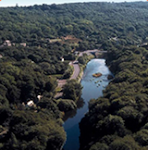Wednesday 3rd September 2025, Green Acres Farm
As there is a bumper bundle of photographs available for this report I have not tried to merge them into the text but placed them after the description of the day.
Hope that is OK!
Green Acres is a farm on the edge of Kemberton. It has been an organic farm for 25 years or so and is mainly arable, although it does also have some sheep. It is spread over more than one site; the area we were visiting consisted of a number of large arable fields that had recently changed to an Agriforestry regime.
Over last winter, strips of a various native trees were planted about 35 metres apart, running east/west across the fields. In addition, 3 metre borders of wildflower mix were sown on each side of the trees.
Unfortunately, the wildflower borders failed to take and the plan is to try again next year. Currently most of the strips look like this.
However there were a few that were showing signs of growth although they were lacking their wildflower borders.
In effect we were carrying out our survey at the start of the process of converting to the new scheme.
Well...
Almost!
The reason for the conversion is to make the farm more welcoming to wildlife.
The owners are keen to see how wildlife responds to the change over the coming years, in the expectation that improvements will be seen. The farm can then be used as an example of how other farms could benefit from this approach.
After a brief introduction from the farmer, which I have paraphrased above, we moved onto the farm, walking down a track with a well established hedge, to one of the strips. Here we started our searches for things of interest in the narrow grassy areas that bordered the trees.
There are about 25 similar strips, but we did not search them all! Just bits of a couple, before moving on to an area of recently planted woodland.
Here, the trees were still young but the vegetation that had grown around them proved very productive.
We stayed in this area for the rest of the morning.
When I noticed that a couple were no longer able to walk about (due to hunger?)…
I called lunch.
Originally the plan was to return to the classroom where we had had the introduction from the farmer, where there were suitable facilities available to us (and it had a roof!), but the weather was so good we had lunch where we were.
After lunch we spent a little more time in this area.
As we were thinking about moving on, we peered around the substantial hedge and noticed an approaching storm.
It did not spare us.
We sought shelter from whatever cover we could find.
Thankfully, the storm did not last very long and we were able to proceed in dribs and drabs to the far end of the track, to an area where wildflowers were growing.
This area also proved fruitful.
More rain!
Fortunately a large oak and a horse chestnut provided adequate cover.
It was a short sharp burst, but it was enough to bring proceedings to an end. We returned back to the classroom.
After a brief discussion with the owner about what we had found, we went home.
At last, photographs of some of the species we observed during the day.
Beetles
A ground beetle, Amara aenea.
A Clover-root Weevil, Sitona hispidulus.
Another ground beetle, Curtonotus aulicus.
A leaf beetle, Gastrophysa polygoni (and companion).
Another weevil, Pelenomus quadrituberculatus.
Ladybirds
Yes, I know they are also beetles but they deserve their own section.
A 22-spot Ladybird, Psyllobora vigintiduopunctata.
A couple of Adonis Ladybirds, Adonia variegata.
An Angle-spotted Ladybird, Scymnus frontalis.
A pair of Meadow Ladybirds, Rhyzobius litura, on the left and right, and a 16-spot Ladybird, Tytthaspis sedecimpunctata, in the middle, acting as a chaperone.
Butterflies and moths
A well-disguised twig-like larva of a Blood-vein moth, Timandra comae. (We also saw an adult, but failed to photograph it.)
A Common Blue, Polyommatus icarus.
A boldly patterned larva of a Knotgrass moth, Acronicta rumicis.
True Bugs
A Dock Bug, Coreus marginatus.
A Green Shieldbug, Palomena prasina.
A Hawthorn Shieldbug, Acanthosoma haemorrhoidale.
Grasshoppers and Crickets
A female Field Grasshopper, Chorthippus brunneus.
A female Lesser Marsh Grasshopper, Chorthippus albomarginatus.
A male Long-winged Conehead, Conocephalus fuscus.
A female Oak Bush-cricket, Meconema thalassinum.
A female Speckled Bush-cricket, Leptophyes punctatissima.
Earwigs
A male Common Earwig, Forficula auricularia.
A female Lesne’s Earwig, Forficula lesnei.
Spiders
A Furrow Orb Weaver, Larinioides cornutus.
A Missing Sector Spider, Zygiella x-notata, so called as often the upper part of the the spider's web is open, i.e. does not contain any spiral threads between the spokes.
Another spider, a male Nigma walckenaeri.
A Nursery Web Spider, Pisaura mirabilis.
Harvestmen
A Fork Palped Harvestman, Dicranopalpus ramosus agg.
And Nemastoma bimaculatum.
Others
A Common Rough Woodlouse, Porcellio scaber.
A Knopper Gall on an acorn, caused by the development of the asexual generation of the gall wasp Andricus quercuscalicis.
A Ruddy Darter, Sympetrum sanguineum.
Weevil of the Week
Yes, the occasional series, Weevil of the Week, returns this week. Our featured weevil is Stenocarus ruficornis.
Its larvae are parasites of the Poppy family, initially mining the leaves, then boring through the roots. It is uncommon in this country but considered a pest in others.
And finally a photograph of a very, very young and cute Dock Bug nymph.
My thanks to the owners for inviting us to visit and do what we enjoy doing. My immense gratitude to the photographers for their excellent images.


































































No comments:
Post a Comment
Please feel free to comment on this post...